Elizabeth Sherrill's Blog, page 2
November 23, 2013
Easy to Assemble
"What do you want for your 90th birthday?"
John had his answer ready: "A kitchen island!"
I might have known it would be some accessory for his hobby and passion: cooking. (A passion he didn't develop, to my sorrow, until our three children had grown up.) A kitchen island would be extra counter space for slicing, chopping, stirring...
We went shopping and came back rejoicing from Bed, Bath & Beyond with a large box stamped in bold letters: EASY TO ASSEMBLE.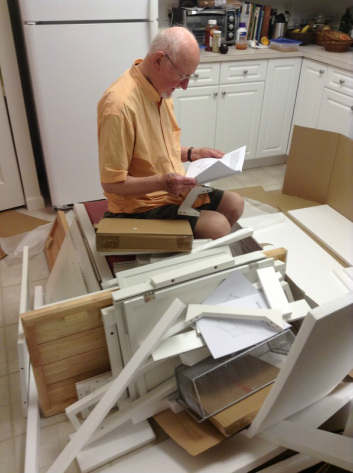
John unpacked the box in the kitchen.
By the time he'd read the 16 pages of directions, it was too late to start dinner. Anyway, there was no room in the kitchen.
We went to nearby Nino's.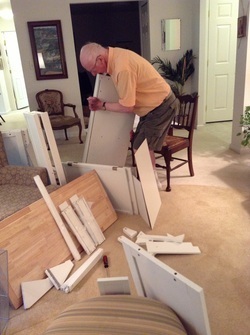
After several days of standing up for breakfast and lunch and eating out for dinner -- with parts H1, H7 and Q4 now triumphantly attached -- John moved the project to the living room.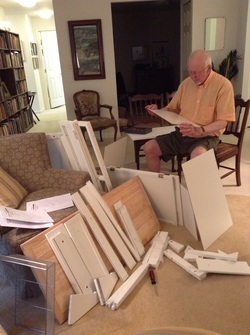
There it stayed while he restudied the instructions and disassembled parts H1. H7 and Q4.
Three weeks later, tired of an unlivable living room, we moved all the pieces into the guest room.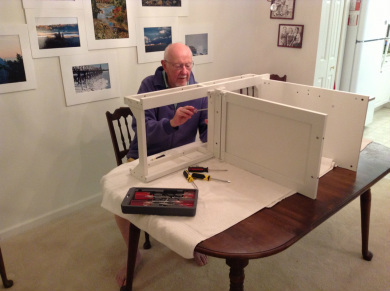 Eventually,friends from New York arrived and the project -- now "coming along nicely" -- was transferred to the dining room table.
Eventually,friends from New York arrived and the project -- now "coming along nicely" -- was transferred to the dining room table.
We served breakfasts and lunches to our New York friends on a card table in the living room., and took them out to dinner. (John was too busy wrestling with the kitchen island to cook.).
Finally, three months after opening the EASY TO ASSEMBLE box, John called our son-in-law, Dana, for help. Dana is a rocket scientist who assured us that assembling the island was no harder than designing the homing device in nose of a missile.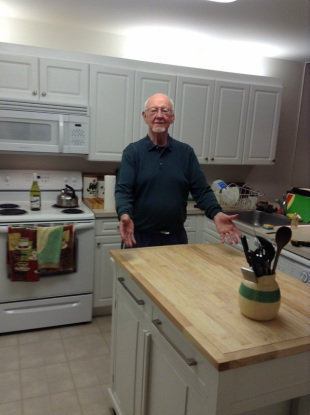
Happy Birthday, John!
John had his answer ready: "A kitchen island!"
I might have known it would be some accessory for his hobby and passion: cooking. (A passion he didn't develop, to my sorrow, until our three children had grown up.) A kitchen island would be extra counter space for slicing, chopping, stirring...
We went shopping and came back rejoicing from Bed, Bath & Beyond with a large box stamped in bold letters: EASY TO ASSEMBLE.

John unpacked the box in the kitchen.
By the time he'd read the 16 pages of directions, it was too late to start dinner. Anyway, there was no room in the kitchen.
We went to nearby Nino's.

After several days of standing up for breakfast and lunch and eating out for dinner -- with parts H1, H7 and Q4 now triumphantly attached -- John moved the project to the living room.

There it stayed while he restudied the instructions and disassembled parts H1. H7 and Q4.

Three weeks later, tired of an unlivable living room, we moved all the pieces into the guest room.
 Eventually,friends from New York arrived and the project -- now "coming along nicely" -- was transferred to the dining room table.
Eventually,friends from New York arrived and the project -- now "coming along nicely" -- was transferred to the dining room table.We served breakfasts and lunches to our New York friends on a card table in the living room., and took them out to dinner. (John was too busy wrestling with the kitchen island to cook.).

Finally, three months after opening the EASY TO ASSEMBLE box, John called our son-in-law, Dana, for help. Dana is a rocket scientist who assured us that assembling the island was no harder than designing the homing device in nose of a missile.

Happy Birthday, John!
Published on November 23, 2013 14:51
June 14, 2013
Getting to Know Charles
 We're back in France, where we've had another experience that makes it fun to travel without a plan. As so often, we headed for a particular dot on our road map because we were intrigued by the name: Colombey-les-Deux-Eglises (Colombey-the-Two-Churches.)
We're back in France, where we've had another experience that makes it fun to travel without a plan. As so often, we headed for a particular dot on our road map because we were intrigued by the name: Colombey-les-Deux-Eglises (Colombey-the-Two-Churches.) The town, when we reached it, looked hardly big enough to support one church, let alone two. But it had a little hotel with flowers in the window boxes. When we'd carried in our bags we got back in the car and went to find the two churches. One Catholic, one Evangelical? we'd wondered.
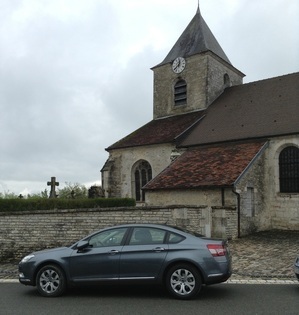 Certainly not! "Certainement pas!"
Certainly not! "Certainement pas!" The man sweeping the street in front of the church where we'd parked sounded horrified at the very thought of a diversity of churches. It seemed that centuries ago there'd been an abbey here with its own church for the monks -- both church and monks long gone.
That left us with just the one church to visit. We almost went back to the hotel without bothering, it looked so like a score of other village churches we'd passed that day, some of which we'd stopped to look at, each surrounded with its cemetery behind an encircling wall.

As we looked through the gate, though, we caught sight of fresh flowers, unusual in these forgotten-looking village cemeteries. Stepping inside, we saw a fresh bouquet and a plaque "to the memory of General De Gaulle" at the foot of a cross.

Other plaques in his honor were stacked five and six deep against the side of the church -- two sides of the church, in fact, were lined with these tributes from various organizations around the country. We learned later that there's never been a week since his death in 1970 that fresh flowers haven't been left here "for the General."
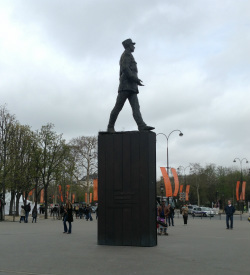
It wasn't our first encounter with him on the trip. We'd landed at Charles De Gaulle airport outside Paris, and passed him on his lofty perch on the Champs Elysses.
 Searching now among the often-ornate headstones of the little country cemetery, we came upon an eloquently simple one. The stone on the right marks the grave of De Gaulle and his wife, Yvonne, the one on the right, their daughter Anne with the dates 1928-1948. I remembered reading occasionally about the De Gaulles' son Phillipe and their daughter Elisabeth, but never about Anne.
Searching now among the often-ornate headstones of the little country cemetery, we came upon an eloquently simple one. The stone on the right marks the grave of De Gaulle and his wife, Yvonne, the one on the right, their daughter Anne with the dates 1928-1948. I remembered reading occasionally about the De Gaulles' son Phillipe and their daughter Elisabeth, but never about Anne. We learned her story next day at the big new De Gaulle museum on the outskirts of this tiny town. We learned, too, about the immense construction we'd seen from many miles away the previous day. A military installation? An enormous satellite tower? It was the Croix de Lorraine, a museum guide explained, the Lorraine Cross chosen be De Gaulle during the long Nazi occupation as the emblem of Free France. I remembered, then, selling stamps with this symbol around my high school to raise money for the Free French fighters.
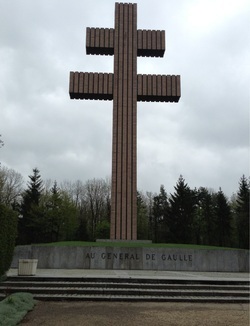
I took an elevator to the roof of the museum, then climbed some more to the top of the hill where the cross stands. Ponderous and graceless, I thought, but still a powerful symbol of the man who flew to England while the French leadership was making deals with the victorious Nazis, broadcast an appeal to his countrymen to resist, and led that resistance for four long years.
 Museum entrance: my favorite statue of De Gaulle. Most of the museum is given to exhibits about the war and De Gaulle's political career afterward.
Museum entrance: my favorite statue of De Gaulle. Most of the museum is given to exhibits about the war and De Gaulle's political career afterward. But one room is dedicated to his family. Phillipe and Elisabeth have had distinguished careers of their own. But the youngest, Anne, was born with Down's Syndrome, a condition "little understood in 1928," when most such children were cared for in institutions. The De Gaulles kept Anne at home. Though she never learned to talk, and didn't walk until age 10, she was her father's special joy. He sang to her at bedtime each night, walked her about the estate that they bought in Colombey-les-Deux-Eglises largely because doctors thought the country air would benefit Anne's fragile health.

We liked this glimpse of another side of this combative man and went to see the estate, "La Boisserie."
The house is at the foot of this drive, large but unpretentious, with the views over the surrounding farmlands that Anne especially enjoyed.

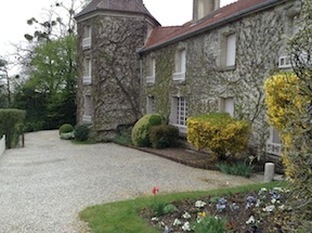 We were glad we'd stopped at the Town-with-Two-Churches!
We were glad we'd stopped at the Town-with-Two-Churches!
Published on June 14, 2013 09:40
June 10, 2013
More Padlocks
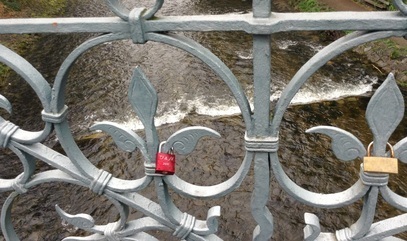 When I wrote in April about the padlocks on a bridge in Paris, our friend Joan emailed to say she'd noticed the same romantic tradition in Salzburg. So we kept our eyes open and sure enough, we saw these little "Together Forever" tokens in Freiburg . . .
When I wrote in April about the padlocks on a bridge in Paris, our friend Joan emailed to say she'd noticed the same romantic tradition in Salzburg. So we kept our eyes open and sure enough, we saw these little "Together Forever" tokens in Freiburg . . .In Heidelberg . . .
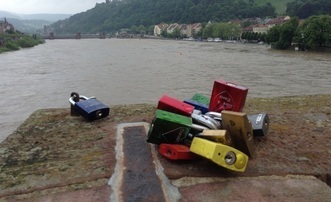
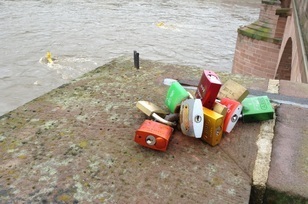 Since the ancient stone bridge here has no railings, couples attach their padlocks to the bits of iron remaining from its construction.
Since the ancient stone bridge here has no railings, couples attach their padlocks to the bits of iron remaining from its construction. And most wonderfully of all, in Munich . . .
And most wonderfully of all, in Munich . . .This is the Eisbach, a torrent of water that appears seemingly from nowhere below an ordinary city street.
John waited a long time at a bus stop 20 feet away without suspecting the drama going on so close to him.
Because where the water gushes out of its underground channel, it creates a wave beloved by surfers.
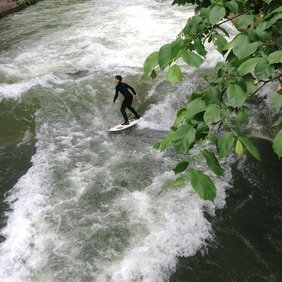
 The rule is strictly one at a time! Years ago, when our grandson Andrew, backpacking through Europe in his bachelor days, wrote that he was surfing in Munich, we'd wondered where the waves were! We know now: there's only one wave and it lasts forever . . .
The rule is strictly one at a time! Years ago, when our grandson Andrew, backpacking through Europe in his bachelor days, wrote that he was surfing in Munich, we'd wondered where the waves were! We know now: there's only one wave and it lasts forever . . .
Published on June 10, 2013 13:03
June 8, 2013
Umleitung!
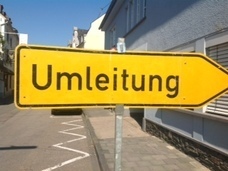 From Heidelberg John and I headed to the Rhine -- and so of course did the Neckar, with its overflow of water. We'd had a notion of driving north along the road that hugs the west side of the Rhine, and did this until the first yellow UMLEITUNG ("Detour") sign sent us up into the woods and vineyards high above: the road ahead was under water.
From Heidelberg John and I headed to the Rhine -- and so of course did the Neckar, with its overflow of water. We'd had a notion of driving north along the road that hugs the west side of the Rhine, and did this until the first yellow UMLEITUNG ("Detour") sign sent us up into the woods and vineyards high above: the road ahead was under water. After a few miles, the detour signs led us back to the river, only to point us uphill again around another flooded stretch of the shore road.
Thinking that the road on the opposite bank might be better, we took a ferry across to Lorch.
 And a churning, lurching
And a churning, lurchingbattle it was, this small boat against the swift current. The ferry crossing was closed later that day.
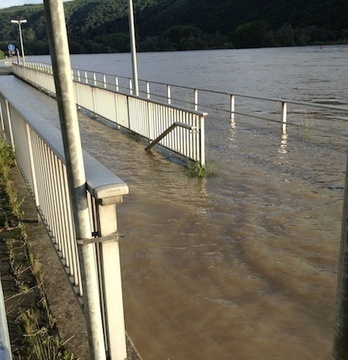 The east bank had as many umleitungs as the west. We found a room for the night in the charming, flower-lined little riverside village of Assmannshausen where our hostess told us there was a walk we could take in the morning right at the river's edge. "Don't try to cross the busy highway. There are stairs that will take you to a tunnel underneath it."
The east bank had as many umleitungs as the west. We found a room for the night in the charming, flower-lined little riverside village of Assmannshausen where our hostess told us there was a walk we could take in the morning right at the river's edge. "Don't try to cross the busy highway. There are stairs that will take you to a tunnel underneath it."In the morning we walked across the deserted highway strung with red and white Hoch Wasser (High Water) streamers and saw where the stairs come up from the tunnel . . .
Doubtless that outer railing lines the river walk.
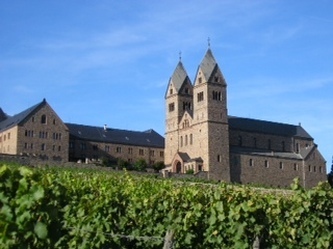 Since we both enjoy the 12th century music of Hildegard of Bingen, we were delighted to hear that the Abbey of St. Hildegard was only a 20-minute drive from Assmannshausen. Twenty minutes, that is, if the river road hadn't been closed. In our case it was an hour and ten minutes of hairpin turns through hamlets and vertical vineyards, praying that no one was coming the other way.
Since we both enjoy the 12th century music of Hildegard of Bingen, we were delighted to hear that the Abbey of St. Hildegard was only a 20-minute drive from Assmannshausen. Twenty minutes, that is, if the river road hadn't been closed. In our case it was an hour and ten minutes of hairpin turns through hamlets and vertical vineyards, praying that no one was coming the other way. It was worth every tire-squealing turn to visit this hushed and holy place with its black-robed nuns and great deep-toned bells we could hear long before we could see the twin steeples.
 Enroute, however, the detour took us through the Nieder Wood and the grandiose, over-sized monument to a very different Germany. "Germania" is a colossal Teutonic goddess standing above a frieze of spike-helmeted generals. Doubtless when it was erected in the 1880s to celebrate the uniting of the German people under the Prussian king, it caused appropriate sentiments of national pride. But given the terrifying and tragic history of the 20th century, it seemed to us to glorify exactly the wrong qualities of the country.
Enroute, however, the detour took us through the Nieder Wood and the grandiose, over-sized monument to a very different Germany. "Germania" is a colossal Teutonic goddess standing above a frieze of spike-helmeted generals. Doubtless when it was erected in the 1880s to celebrate the uniting of the German people under the Prussian king, it caused appropriate sentiments of national pride. But given the terrifying and tragic history of the 20th century, it seemed to us to glorify exactly the wrong qualities of the country.(We're never far from our traveling companion, Louis XIV. We met him in Heidelberg, which he pretty much destroyed in an effort to annex it, and we spotted him even here at this most-German site. A signboard displays a reproduction of a painting of Kaiser Wilhelm in 1871 crowning himself as German Emperor amid a throng of much-medalled officers. The place isn't identified, but it's unmistakably Louis' Hall of Mirrors at Versailles.)
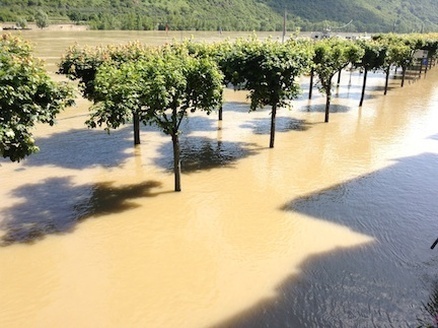 After two days in Assmannshausen we crossed back to the Rhine's west shore (the bridge at Wiesbaden) and are now at Hotel Gunther in Boppard with a view from our balcony of what everyone tells us is a lovely tree-lined river promenade.
After two days in Assmannshausen we crossed back to the Rhine's west shore (the bridge at Wiesbaden) and are now at Hotel Gunther in Boppard with a view from our balcony of what everyone tells us is a lovely tree-lined river promenade.  I'm sure the Gunther has a welcoming front door on the river side. We'll never see it -- and we'll never forget how we entered instead. A thoughtful local man, seeing us in obvious perplexity, asked if we were looking for a hotel.
I'm sure the Gunther has a welcoming front door on the river side. We'll never see it -- and we'll never forget how we entered instead. A thoughtful local man, seeing us in obvious perplexity, asked if we were looking for a hotel. "There's one right here," he said, pointing to this unpromising alley.
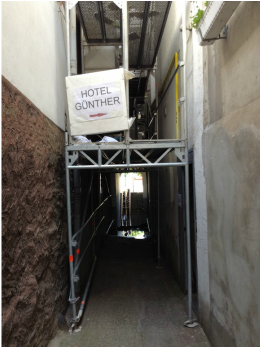 A few feet into it, sure enough we saw the sign: Hotel Gunther.
A few feet into it, sure enough we saw the sign: Hotel Gunther.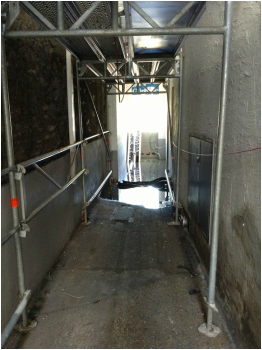 Deftly sidestepping the water, we ducked beneath a low door -- too dark, photo didn't come out -- walked through the hotel kitchen, and had arrived!
Deftly sidestepping the water, we ducked beneath a low door -- too dark, photo didn't come out -- walked through the hotel kitchen, and had arrived! The strangest thing, to John and me, about this silent brown (!) Rhine, is the absence of river traffic.
The strangest thing, to John and me, about this silent brown (!) Rhine, is the absence of river traffic. 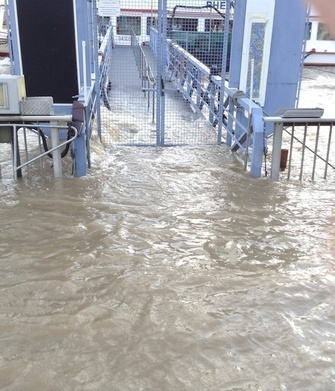 We made this trip by boat four years ago and remember best of all the enormous barges and other commercial shipping constantly plowing north or south. Pleasure boats too, sailboats and yachts, fleets of tour boats like our own -- a constant procession and pulse of tugboat engines. Nothing is moving now, the long barges tethered, the sad excursion boats moored, water pouring over their gangways.
We made this trip by boat four years ago and remember best of all the enormous barges and other commercial shipping constantly plowing north or south. Pleasure boats too, sailboats and yachts, fleets of tour boats like our own -- a constant procession and pulse of tugboat engines. Nothing is moving now, the long barges tethered, the sad excursion boats moored, water pouring over their gangways. 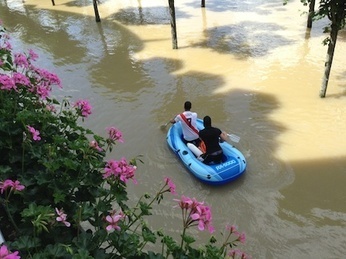 This is about the only thing moving on the Rhine right now.
This is about the only thing moving on the Rhine right now.We feel sorry for all the out of work bargemen and all the people who planned boat trips -- and just a little guilty at sitting here on our balcony with the window boxes of pink geraniums, delighting in this river in all its moods.
Published on June 08, 2013 08:32
June 1, 2013
Rain
 June 1
June 1Well, we have the answer . . . We've been saying each morning since we arrived in England April 1st, waking to yet another rainy day, where is all this water going to go?
It was going here to the Neckar.
This was the scene from our balcony this morning. Last night, the row of trees stood on the bank of the Neckar, with a lawn, flowerbeds and a broad pedestrian/bicycle lane where John and I strolled (under umbrellas: we haven't taken a walk without these on the entire trip.)
 Same scene yesterday:
Same scene yesterday:And this is what it sounded like:
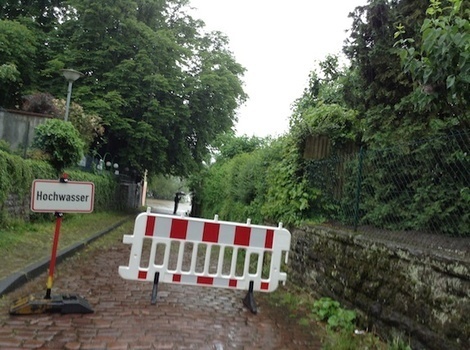 It's clear that flooded streets aren't that unusual. Last night police were placing these Hoch Wasser (High Water) signs and the handy temporary barriers at several low places; today they simply moved them higher. The faint figure in the background is John (under umbrella) trying to find the place where we parked for supper last night.
It's clear that flooded streets aren't that unusual. Last night police were placing these Hoch Wasser (High Water) signs and the handy temporary barriers at several low places; today they simply moved them higher. The faint figure in the background is John (under umbrella) trying to find the place where we parked for supper last night. 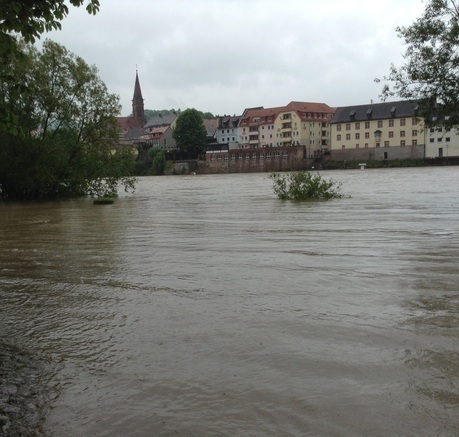 Yes! There it was: there's a little cafe just out of the picture to the left and our car was parked beside what was a fairly tall bush, top right. We were safely back at our hotel high above the river long before the water rose. We went back today to see if the cafe owner was right when he said water never flooded HIS street.
Yes! There it was: there's a little cafe just out of the picture to the left and our car was parked beside what was a fairly tall bush, top right. We were safely back at our hotel high above the river long before the water rose. We went back today to see if the cafe owner was right when he said water never flooded HIS street.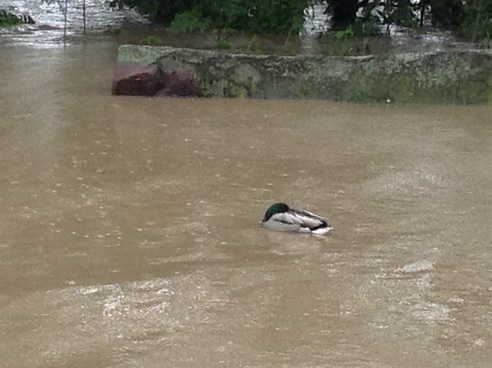 This duck is napping where we walked yesterday.
This duck is napping where we walked yesterday. We drove a few miles downstream to see the high water at Heidelberg: the ground floor was flooded in these houses beside the famous bridge.
We drove a few miles downstream to see the high water at Heidelberg: the ground floor was flooded in these houses beside the famous bridge. Those are sandbags beside the house in the center. Can you make out the ruined castle through the rain?
Those are sandbags beside the house in the center. Can you make out the ruined castle through the rain?"Through the rain" is mostly how we've seen England, France, Switzerland and Germany this spring. Such sad biergartens here, chairs upturned on the table tops, vines on overhead trellises dripping water. John and I have stopped taking photos of ourselves because we can't stand one more of me in that brown cap and John in his winter coat. But gray weather notwithstanding (it's prolonged the spring so that we saw tulips yesterday!) we wouldn't rather be doing anything else than taking this rambling trip . . .
Published on June 01, 2013 09:16
May 29, 2013
The Joy of Ignorance
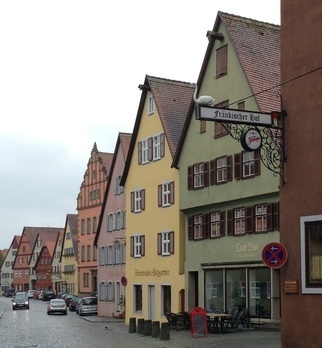 John and I like to travel, as I've mentioned, without a plan -- we didn't even know as we set out this time, what countries we'd go to.
John and I like to travel, as I've mentioned, without a plan -- we didn't even know as we set out this time, what countries we'd go to.Of course this means missing a lot. Always after a trip someone will say, shocked and reproachful, "You mean you went to XXX and didn't see the XXX??!"
But what we do see has the excitement of discovery. Suddenly, stunningly, we find ourselves somewhere that had been only a name. Like the time, following a narrow road winding through Tuscan olive groves, we passed a weatherbeaten little sign: VINCI. Sure enough, we'd stumbled on Leonardo's home town; a man on a bicycle directed us to the farmhouse where the great artist was born.
It happened again this week. Not a town we'd heard of, this time, though apparently we should have. I can hear people when we get home, "Dinkelsbuhl? Why, EVERYBODY knows Dinkelsbuhl!"
John and I didn't, however. It was getting late, time to leave the small roads we'd been roaming and get to some town large enough to have a room for overnight. On our map of Bavaria several places within a 30-minute drive looked possible, but the name "Dinkelsbuhl" made me chuckle, so I suggested that one.
We arrived at a formidable-looking wall and followed it to a gateway in an ancient stone tower. We drove through it and gasped. Half-timbered houses -- red, blue, green, yellow -- steep red-tiled roofs, cobblestoned streets, old German lettering on the shop fronts -- it was like stepping into a time warp. A perfectly preserved town from the 1500s! There were even several wagons harnessed to draft horses waiting just inside the gate.
"It's like a theme park," John said, "except that it's real." We parked the car and wandered, entranced, through narrow alleys and picture-book squares.
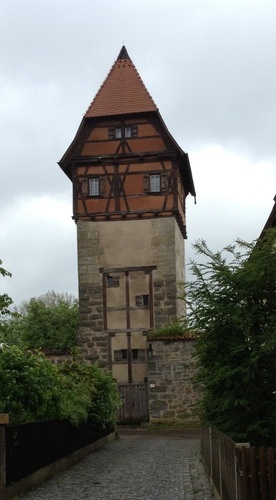 One of the dozen towers still standing guard on the walls.
One of the dozen towers still standing guard on the walls.
 Worn steps to the gallery where the town militia would climb to defend the walls.
Worn steps to the gallery where the town militia would climb to defend the walls.
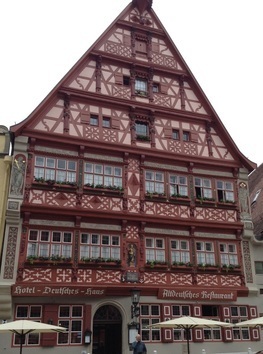 Our hotel. Returning to the gate, a little later, we saw a large blue tour bus. As some 50 Japanese tourists emerged and climbed into the waiting wagons, we realized that we hadn't been the first people to discover this atmospheric place . . .
Our hotel. Returning to the gate, a little later, we saw a large blue tour bus. As some 50 Japanese tourists emerged and climbed into the waiting wagons, we realized that we hadn't been the first people to discover this atmospheric place . . .The delight of personal discovery remains, though. We're staying three days in the 500-year-old home of a well-to-do Dinkelsbuhl family, perfectly restored with its painted ceilings and tapestried walls.
 Base Camp. And one extremely authentic touch: No Elevator.
Base Camp. And one extremely authentic touch: No Elevator.Our room was on the second floor (European style, third floor to us) up two of the longest, steepest flights of stairs we've encountered since stairs became a challenge for us. John's knees, my hip joints, and both our hearts complain piteously nowadays at more than a couple of steps.
But the ancient house was so irresistible that we've settled on a rule (take everything with you when you leave the room or do without it) and a workable approach to stair climbing. We establish our base camp on the ground floor, and proceed by stages as instructed in mountaineering manuals. This requires learning to pronounce "Entschuldigung!" to beg pardon of all the steel-limbed Germans who bolt up the stairs you're blocking.
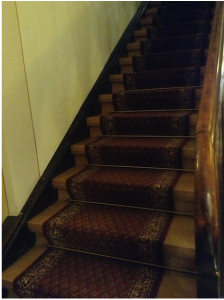 Here, the foot of the final staircase, is where we establish our camp for the assault on the summit.
Here, the foot of the final staircase, is where we establish our camp for the assault on the summit.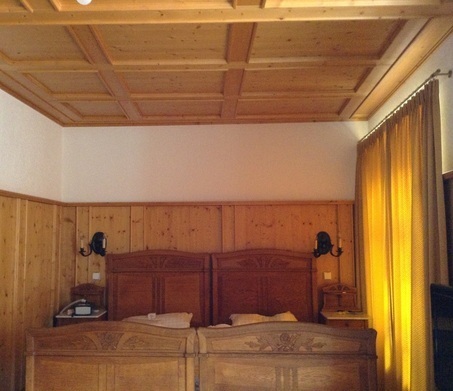 Once we reach our antique room, though, with its coffered ceiling and doppelbett (two single beds side by side; I don't think there's a double mattress anywhere in Germany) and look out on a sea of red tiles, every last step is forgiven.
Once we reach our antique room, though, with its coffered ceiling and doppelbett (two single beds side by side; I don't think there's a double mattress anywhere in Germany) and look out on a sea of red tiles, every last step is forgiven.
Published on May 29, 2013 18:30



